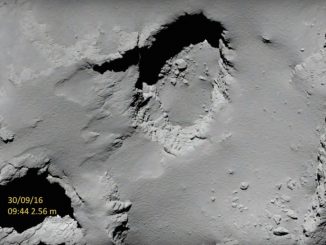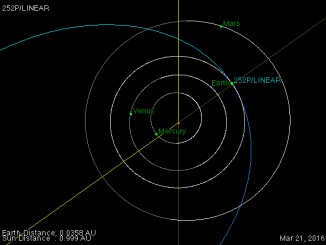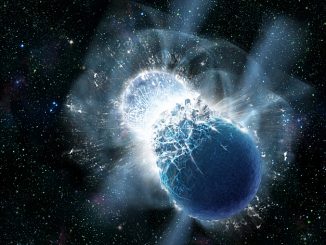
While astronomers cannot yet say what the mysterious objects are that are blocking up to 22 percent of the light from the distant star KIC 8462852, scientist have now determined what they are not, namely debris from a collision between two asteroids or an asteroid impact on a terrestrial planet.
The star in question – now famous as the ‘alien megastructure star’ – is located around 1,480 light years from Earth in the constellation of Cygnus the Swan and was first identified as unusual earlier this year by a group of scientists led by Tabetha Boyajian of Yale University. Subsequently the star, which is a magnitude +11.7 F-type main sequence star, has become known as ‘Tabby’s Star’, named after Boyajian. Her team looked at the star’s light curve – a graph that represents how its brightness changes with time – and found that nearly a quarter of its light was being irregularly blocked by a swarm of objects orbiting it. Nothing like it had ever been seen before and, in a paper submitted to the Monthly Notices of the Royal Astronomical Society, Boyajian concluded that the best explanation was that the transits were being caused by a family of cometary fragments that had formed from the break-up of a single large comet. At the same time, however, Boyajian’s team acknowledged that even the comet explanation was not without its problems – for one, the break-up must have happened at some point in the last few years, which seems a huge coincidence for an event that would seem to be so rare that it has never been observed before around any other star.
However, Boyajian , while not mentioning it in her paper, left one other option open – the possibility that the objects that are blocking the star’s light are artificial, not natural. Although it seems an unlikely possibility, the concept of a Dyson sphere has been present in scientific literature for the best part of a century. The idea is that if a swarm of solar collectors can be built and arranged into a sphere surrounding a star, they can collect most of that star’s radiated energy to power an advanced civilisation – a Dyson sphere built around our Sun, for example, could capture 10^26 watts. While the concept was popularised by theoretical physicist Freeman Dyson in 1960, the origin of the ideas behind it date back to 1929 and John Desmond Bernal’s concept of solar powered space habitats, the basic ideas of which were then further developed by the science fiction author Olaf Stapledon in his 1937 novel Star Maker.
A partial Dyson swarm (a rigid sphere, as the idea is often presented in fiction, would be unstable) of orbiting solar collectors would block some of the light of its star and, potentially, could explain the weird light curve of Tabby’s Star. Of course, such an extraordinary claim requires extraordinary evidence, to paraphrase Carl Sagan, so Boyajian contacted Jason Wright, a professor of astrophysics at Penn State University, USA who has been leading a project known as Glimpsing Heat from Alien Technologies (G-HAT, or Ĝ). Because a Dyson sphere would heat up as it collects radiation from a star, this excess heat would then have to be radiated away as infrared emission. The Ĝ project concerns itself with sifting through astronomical data, in particular from NASA’s Wide-field Infrared Survey Explorer, or WISE, which mapped the Universe in mid-infrared wavelengths, looking for any tell-tale infrared signatures of Dyson swarms.
Wright was intrigued by Tabby’s Star and submitted a paper to The Astrophysical Journal that contemplated the possibility that an incomplete Dyson swarm (it doesn’t surround the whole star) could be the cause, while noting that the hypothesis was still a long-shot and that a natural explanation remained far more likely. However, WISE had not detected any excess infrared light coming from the star. Did that rule out the Dyson swarm hypothesis? Not at all, says Wright.
“It takes a lot less material to block light than to generate lots of infrared light, so it’s not surprising that whatever is blocking this starlight around Tabby’s Star is not detectable in the infrared,” he tells Astronomy Now.

Now astronomers from Iowa State University, who observed the star in January 2015 using NASA’s Spitzer Space Telescope, have been able to rule out some possibilities in a new paper published in The Astrophysical Journal Letters. If it had been an asteroid collision, it would have produced a lot of dust orbiting the star on a circular orbit, and this dust would have been visible in infrared. WISE’s observations of Tabby’s Star date back to 2010 – if the collision had happened after that, WISE would have missed it. However, the more recent Spitzer data also revealed no evidence for infrared emission.
Massimo Marengo, who led the Spitzer observations, thinks this rules out any events relating to asteroids, but does not contradict the cometary hypothesis.
“Breaking up a comet would produce a lot of infrared radiation, but less than an asteroid due to the different composition [more ice compared to pure asteroidal rock],” he tells Astronomy Now. “Comets also tend to have very elliptical orbits, which would allow the debris to clear the zone near the star more rapidly. Even if infrared radiation was produced when the fragments were close to the star, by the time Spitzer made its observations they were too far and too cold to emit a detectable infrared flux.”
While this bolsters the comet explanation, it does not confirm it, nor does it rule out the Dyson swarm hypothesis. Neither does the lack of radio signals heard when the SETI Institute’s Allen Telescope Array in California spent 180 hours listening to the star across a variety of frequencies; Wright, along with Boyajian and Andrew Siemion of the University of California, Berkeley, is also planning to survey Tabby’s Star for radio signals using the mighty Green Bank Telescope in West Virginia, USA, in the New Year. It is likely, however, that there will be no clear cut answer to this for many years to come, which will only encourage the myth surrounding the star to build up. As for Marengo, he is open-minded about the extraterrestrial hypothesis.
“We can’t really say it is, or is not,” he says. “But what the star is doing is very strange.”



